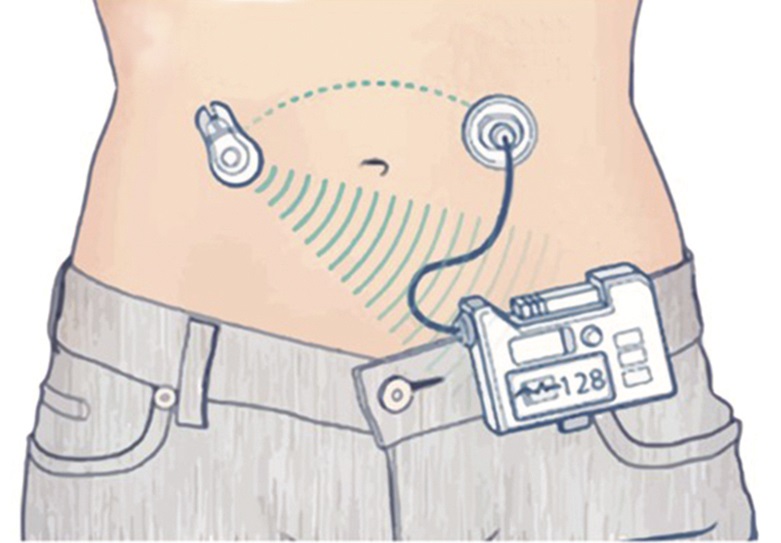
-
- Also known as automated insulin delivery systems, hybrid closed-loop systems, or smart pumps and sensors
- An artificial pancreas system has three main components, two of which you have to wear at all times: an insulin pump, a continuous glucose monitor (CGM), and an algorithm (the “brain” that determines the best insulin dose to help keep you in range”)
- Measures glucose and adjusts insulin automatically; gives less insulin when blood sugar is low and more insulin when blood sugar is high
-
- Requires fewer decisions/calculations as the system does much of it for you
- More time in range with fewer highs and lows
- Fewer finger sticks and injections
- Has been shown to improve time-in-range, even during sleep
-
- Requires wearing two devices at all times
- Daily T1D management still required (count carbs, boluses, adjust for exercise, etc.)
- More alerts and alarms, can cause “alarm fatigue” for some
Artificial Pancreas/ Automated Insulin Delivery Systems Available in the U.S.*
|
|
Beta Bionics iLet |
Insulet Omnipod® 5 |
Medtronic MiniMed™ 630G System |
Medtronic MiniMed™ 770G System |
Medtronic MiniMed™ 780G System |
Tandem Diabetes Mobi with Control-IQ Technology |
Tandem Diabetes t:slim X2™ with Basal-IQ/Control-IQ Technology |
DIY |
|
FDA Approved? |
Yes |
Yes |
Yes |
Yes |
Yes |
Yes |
Yes |
No |
|
Ages |
6+ |
2+ |
14+ when used with Guardian™ Sensor 3, |
2+ |
7+ |
6+ |
6+ |
n/a |
|
CGM Pairing |
Dexcom® G6 & Dexcom G7 |
Dexcom G6 |
Medtronic |
Medtronic |
Medtronic |
Dexcom G6 & Dexcom G7 |
Dexcom G6, Dexcom G7, & Freestyle Libre 2 Plus |
n/a |
|
Basal automation? |
Yes |
Automated basal insulin delivery calculated from total daily insulin, which is updated with each pod change |
Automated basal suspension to respond to hypoglycemia |
Automated basal insulin delivery calculated based on total daily insulin from past 2-6 days (“auto basal”) |
Automated adjustment of basal insulin delivery. |
Automated basal insulin delivery that increases or decreases programmed basal rates |
Automated basal insulin delivery that increases or decreases programmed basal rates |
Yes (OpenAPS and Loop) |
|
Bolus automation? |
Yes |
No (adaptive basal only to respond to hyperglycemia) |
No |
No (adaptive basal only to respond to hyperglycemia). When a BG over 150 mg/dL is entered, Auto Mode may recommend a correction bolus. |
Yes, auto-correction bolus |
Yes, auto-correction bolus |
Yes, auto-correction bolus (Control-IQ only) |
n/a |
|
High/Low Blood Glucose Alerts |
Yes |
Yes |
Yes |
Yes |
Yes |
Yes |
Yes |
n/a |
|
Smartphone Enabled? |
No |
Yes |
No |
Yes |
Yes |
Yes |
Yes |
Yes (OpenAPS and Loop) |
|
Software Updates? |
Yes |
Yes |
No |
Yes |
Yes |
Yes |
Yes |
n/a |
|
More Information |
Medtronic MiniMed 630G website |
Medtronic MiniMed 770G website |
Medtronic MiniMed 780G website |
n/a |
*Updated February 2024
Getting an artificial pancreas system
If you think an artificial pancreas system might be right for you, consult with your physician.
Resources for Healthcare Professionals
View JDRF’s T1D resources for healthcare professionals.
Original content developed by Med-IQ in collaboration with JDRF.